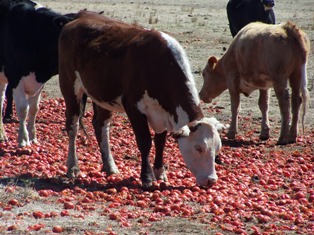With summer upon us, livestock producers are reminded to ensure horticultural by-products fed to their animals are fit for purpose and free from unacceptable chemical residues. Horticultural by-products used as stock feeds can jeopardise valuable livestock markets if they are contaminated with chemicals not intended for livestock consumption.
Some of the more common novel by-products used as stock feeds includes grape marc, grape seed meal, tomato pomace, vegetable leaves, almond hulls and citrus pulp.
DPI Chemical Standards Officer Alex Perera said that before feeding by-products to livestock, growers needed to check which chemicals had been applied and that unacceptable residues were unlikely to be present.
“This will minimise the risk of unacceptable chemical residues being detected in livestock products, including meat, milk and eggs,” Ms Perera said.
“Some chemical products include label statements directing that by-products should never be fed to livestock, such as ‘DO NOT feed treated tomato crops to livestock’. “Crops treated with these products must not be sold for stock feed".

“Failure to comply with label warnings and withholding periods can lead to unacceptable chemical residues in livestock products and put markets at risk.”
It is an offence in Victoria to sell agricultural produce and by-products if the withholding period has not expired, unless the seller notifies the buyer in writing.
Under the Agricultural and Veterinary Chemical (Control of Use) Act 1992, individuals found not to have notified the buyer in writing of any withholding periods that have not elapsed may be fined up to $14,084. Businesses face even heavier penalties. It is also an offence under this Act to sell contaminated agricultural produce, including stock feed.
Some agricultural chemicals do not have a withholding period for livestock specified on the label. These products must not be detectable in livestock when slaughtered unless a maximum residue limit (MRL) has been set.
MRLs can be found on the Food Standards Australia New Zealand website, and the Australian Pesticides and Veterinary Medicines website, Ms Perera said using vendor declarations when trading in by-products can help buyers to minimise the risk of unacceptable chemical residues occurring in livestock products.
“Providing a by-product vendor declaration helps the next user to understand the production process and which chemicals have been applied to the stock feed.”
For more information, or to download a vendor declaration, visit the Meat and Livestock Association website www.mla.com.au



